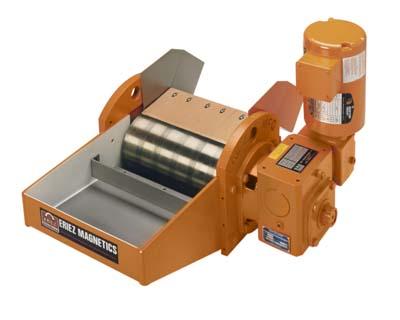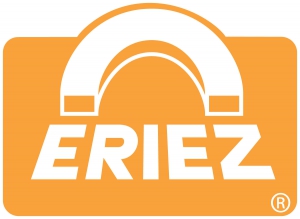
Demands for higher production rates and closer tolerances at lower costs spurred the development of state-of-the-art Eriez Coolant Cleaners. These Coolant Cleaners keep machine tools running longer and more accurately, with lower costs per unit produced.
Eriez Magnetic Coolant Cleaners are for use with surface grinders, gear grinders, honing and lapping machines, broaches, milling and drilling machines, face grinders, oil reclaiming machines or wherever clean coolant is needed.
Permanent Magnetic Coolant Cleaners are available in 36 standard units to match users' requirements of flow rate, viscosity and degree of separation desired. These models come in nine magnetic roll widths ranging from 7 to 70 inches (178 to 1780mm). Two types of rolls are offered. For normal conditions, a smooth faced roll is used. For an even more powerful magnetic field, best for removingµm-sized particles, extended-pole plates are provided.
The Eriez Xtractor Rare Earth Coolant Cleaner uses a powerful magnetic field designed to maximize capture and removal of fine ferrous particles from a coolant. Its unique magnetic circuit design makes the separator much stronger than all other conventional permanent magnetic separators that use alnico or barium ferrite elements.
Available in four sizes, the unit will handle up to 30 gallons per minute of water-soluble coolant per foot of drum width (4 lpm per cm of width). Each model is powered by a standard TEFC 230/460V, 60 Hz, 3-phase motor. Eriez Xtractor Rare Earth Coolant Cleaners can be used in any open process to remove fine ferrous contaminant from slurry. These units also remove grinding swarf to help machine tools run longer and maintain accuracy.
Xtractor Rare Earth Coolant Cleaner applications include the removal of ferrous contaminant from paint processing lines to help ensure the paint does not appear to "rust" once applied. The Xtractor Rare Earth Coolant Cleaner is also used in the steel industry to remove moderately magnetic mill scale from rolling mill cooling water.
Contact Details
Related Glossary Terms
- coolant
coolant
Fluid that reduces temperature buildup at the tool/workpiece interface during machining. Normally takes the form of a liquid such as soluble or chemical mixtures (semisynthetic, synthetic) but can be pressurized air or other gas. Because of water’s ability to absorb great quantities of heat, it is widely used as a coolant and vehicle for various cutting compounds, with the water-to-compound ratio varying with the machining task. See cutting fluid; semisynthetic cutting fluid; soluble-oil cutting fluid; synthetic cutting fluid.
- ferrite
ferrite
Solid solution of one or more elements in body-centered cubic iron. Unless otherwise designated, for instance, as chromium ferrite, the solute is generally assumed to be carbon. On an equilibrium diagram, there are two ferrite regions separated by an austenite area. The lower area is alpha ferrite and the upper area is delta ferrite. If there is no designation, alpha ferrite is assumed. Not more than 0.04 percent carbon can be dissolved in alpha iron. Ferrite is stable below 1,670º F (910º C); it is soft, highly ductile, and magnetic. Ferrite loses its magnetic property above 1,414º F (768º C).
- gang cutting ( milling)
gang cutting ( milling)
Machining with several cutters mounted on a single arbor, generally for simultaneous cutting.
- grinding
grinding
Machining operation in which material is removed from the workpiece by a powered abrasive wheel, stone, belt, paste, sheet, compound, slurry, etc. Takes various forms: surface grinding (creates flat and/or squared surfaces); cylindrical grinding (for external cylindrical and tapered shapes, fillets, undercuts, etc.); centerless grinding; chamfering; thread and form grinding; tool and cutter grinding; offhand grinding; lapping and polishing (grinding with extremely fine grits to create ultrasmooth surfaces); honing; and disc grinding.
- lapping
lapping
Finishing operation in which a loose, fine-grain abrasive in a liquid medium abrades material. Extremely accurate process that corrects minor shape imperfections, refines surface finishes and produces a close fit between mating surfaces.
- milling
milling
Machining operation in which metal or other material is removed by applying power to a rotating cutter. In vertical milling, the cutting tool is mounted vertically on the spindle. In horizontal milling, the cutting tool is mounted horizontally, either directly on the spindle or on an arbor. Horizontal milling is further broken down into conventional milling, where the cutter rotates opposite the direction of feed, or “up” into the workpiece; and climb milling, where the cutter rotates in the direction of feed, or “down” into the workpiece. Milling operations include plane or surface milling, endmilling, facemilling, angle milling, form milling and profiling.
- milling machine ( mill)
milling machine ( mill)
Runs endmills and arbor-mounted milling cutters. Features include a head with a spindle that drives the cutters; a column, knee and table that provide motion in the three Cartesian axes; and a base that supports the components and houses the cutting-fluid pump and reservoir. The work is mounted on the table and fed into the rotating cutter or endmill to accomplish the milling steps; vertical milling machines also feed endmills into the work by means of a spindle-mounted quill. Models range from small manual machines to big bed-type and duplex mills. All take one of three basic forms: vertical, horizontal or convertible horizontal/vertical. Vertical machines may be knee-type (the table is mounted on a knee that can be elevated) or bed-type (the table is securely supported and only moves horizontally). In general, horizontal machines are bigger and more powerful, while vertical machines are lighter but more versatile and easier to set up and operate.
- swarf
swarf
Metal fines and grinding wheel particles generated during grinding.

